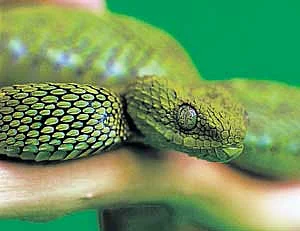

Snakes can “see” in the dark thanks to protein channels that are activated by heat from the bodies of their prey. Vipers, pythons and boas have holes on their faces called pit organs, which contain a membrane that can detect infrared radiation from warm bodies up to one meter away. At night, the pit organs allow snakes to “see” an image of their predator or prey, as an infrared camera does, giving them a unique extra sense.
A study by United States researchers, published in Nature, has now revealed how this works at a molecular level.
Nerve cells in the pit organ contain an ion channel called TRPA1, an infrared receptor that detects infrared radiation as heat, rather than as light, thus confirming theories of pit-organ function long held by behavioral ecologists.
The receptors are also found inside the heads of mammals, where TRPA1 channels, also known as wasabi receptors, detect pungent irritants from mustard plants or other sources.
“Animal physiologists have done beautiful work on the anatomy of this sensory system. That’s really essential information for people like us coming in to do the genetics,” says molecular biologist David Julius at the University of California, San Francisco, who led the study. “What they didn’t know was the molecular logic.”
The pit organ contains nerve fibres known as trigeminal ganglia. The researchers reasoned that a good way to home in on the organ’s molecular heat detectors would be to compare the trigeminal ganglia with the dorsal root ganglia.
Scanning different RNAs
The latter supply the brain with sensory input from the neck down and would be less likely to produce proteins that only pit-organs need to detect heat. The team looked at the different RNAs produced by each type of nerve an indication of which genes are active and producing proteins. They found only one, TRPA1, which was being expressed differently in the two types of ganglia, with the gene in the trigeminal ganglia producing 400 times more RNA than that in the dorsal root ganglia.
The pit organ is part of the snake’s somatosensory system which detects touch, temperature and pain and does not receive signals from the eyes, confirming that snakes “see” infrared by detecting heat, not photons of light. Infrared radiation heats up the pit membrane tissue, and TRPA1 channels open when a threshold temperature is reached, allowing ions to flow into the nerve cells and triggering an electrical signal.
The antenna membrane hangs in a hollow bony chamber, allowing for quick heat loss and maximising the detected temperature differences between warm-blooded animals and everything else. According to the team’s observations, rattlesnake TRPA1 is activated by temperatures higher than about 28 degrees C, roughly the temperature a snake would “feel” from a mouse or a squirrel about a meter away.
More to the pit-organ story
Physiologists and cell biologists agree that although identifying the receptors is an important contribution, there’s more to the pit-organ story.
“The authors used elegant molecular techniques to confirm an idea long substantiated by physiological and behavioral data,” says herpetologist Aaron Krochmal from Washington College in Chestertown, Md. “Although aspects of the findings contradict known behavioral and physiological work, the use of molecular genetic techniques is a new step in understanding how the facial pits work.”
A previous study published in 1956 showed that snakes can detect a human hand better in a refrigerated chamber than at room temperature, according to physiologist George Bakken from Indiana State University in Terre Haute.
“The pit sensory system is clearly functional with sensory ending temperatures well below the reported 28 degrees C threshold,” he says.
The study of how snakes detect infrared radiation has progressed slowly, says neuroscientist Michael Grace from the Florida Institute of Technology in Melbourne: "Perhaps in part because of a general human fear of snakes, and in part because of the real danger posed by pit vipers," he suggests. “The results presented here may be the single most dramatic development in the history of the study of snake infrared imaging.”